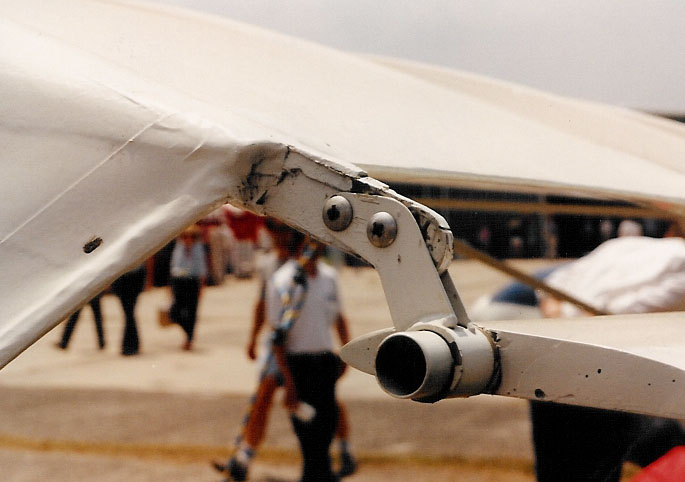| Circumstances
The
pilot was flying the aircraft at an altitude of
about 60 ft in a steep left orbit near the Elizabeth
River. When the pilot reversed the direction of
turn, two of four aileron segments, and what
appeared to be a small piece of fabric, fell from
the left wing. The pilot later reported that the
control column locked after he heard a loud bang. He
retarded the throttle as the aircraft dived out of
control into the river. Impact with the water
destroyed the left wing but the cabin and right wing
remained largely intact. The pilot was able to
extricate himself from the submerged cabin, but his
efforts to free his passenger were in vain.
Several
weeks after the accident, a helicopter search found
two aileron segments still joined by the
interconnecting torque tube. They were recovered
from mangroves 80 m from the river. A third aileron
segment from the left wing was not found.
The
investigation found evidence of deterioration of the
timber wing ribs/aileron hangers from which the
ailerons were suspended. The outer layer of plywood
displayed "tide" marks where the trailing
edge of the wing ribs had been immersed in moisture.
Some ribs were stained by black mould and had
deteriorated due to timber rot. The aircraft had
been standing under a shade cloth roof in hot,
humid, tropical conditions for an extended period.
Moisture had accumulated in the wing and had gone
unnoticed.
About
a year before the accident, two outboard
ribs/aileron hangers had been broken when the left
aileron was pushed against a hangar door. A
subsequent repair had been carried out in accordance
with factory repair instructions. Small sections of
fabric had been removed from the upper wing surface
to facilitate the repair and had been replaced
afterwards. Fabric covering the adjacent third
rib/aileron hanger had not been removed for
inspection. The part was not recovered from the
river.
Examination
by a specialist from the CSIRO Forestry and Forest
Products Division found that the rib/aileron hangers
suspending the inboard aileron segment of the left
wing were profoundly affected by two types of wood
rot. The wood rot caused a significant reduction in
strength of the timber laminates. In addition,
over-tightened bolts holding the aileron hinge
compressed the timber laminates.
Witness
evidence indicated that there were no birds in the
immediate area when the aircraft descended out of
control. The wreckage was examined for any evidence
of bird-strike damage. None was found. Two of three
propeller blades were broken by impact with water
and rocks. The pilot's assessment that the control
column locked, was confirmed by discovery of a bent
torque tube holding the inboard segment of left
aileron which had streamlined in the airflow.
Safety
Action
As
a result of this occurrence and the subsequent
discovery of two other aircraft found to have
sustained similar structural deterioration due to
moisture ingress, the aircraft manufacturer issued
Service Bulletin No 24 on 27 February 1998. This
Service Bulletin required an immediate inspection of
the aileron hanger ribs of factory-built aircraft
which had accumulated more than 300 flight hours or
were more than 12 months old. The Civil Aviation
Safety Authority issued Airworthiness Directive
AD/CA25/7 requiring inspection in accordance with
the manufacturer's service bulletin by 3 March 1998
or before further flight.
|


